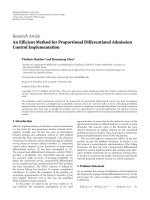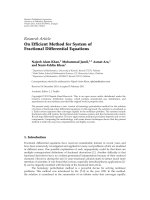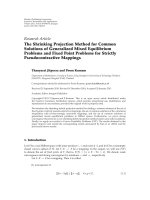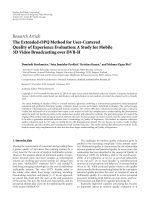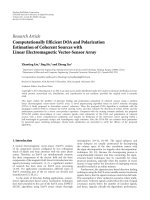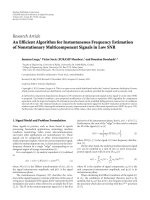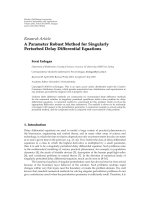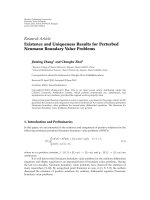Báo cáo hóa học: " Research Article An Efficient Method for Proportional Differentiated Admission Control Implementation" potx
Bạn đang xem bản rút gọn của tài liệu. Xem và tải ngay bản đầy đủ của tài liệu tại đây (564.34 KB, 5 trang )
Hindawi Publishing Corporation
EURASIP Journal on Wireless Communications and Networking
Volume 2011, Article ID 738386, 5 pages
doi:10.1155/2011/738386
Research Article
An Efficient Method for Proportional Differentiated Admission
Control Implementation
Vladimir Shakhov
1
and Hyunseung Choo
2
1
Institute of Computational Mathematics and Mathematical Geophysics of SB RAS, Prospect Akademika Lavrentjeva, 6,
Novosibirsk 630090, Russia
2
School of Information and Communication Engineering, Sungkyunkwan University, Chunchun-Dong 300, Jangan-Gu,
Suwon 440-746, Republic of Korea
Correspondence should be addressed to Hyunseung Choo,
Received 14 November 2010; Accepted 11 February 2011
Academic Editor: Boris Bellalta
Copyright © 2011 V. Shakhov and H. Choo. This is an open access article distributed under the Creative Commons Attribution
License, which permits unrestricted use, distribution, and reproduction in any medium, provided the original work is properly
cited.
The admission control mechanism inspired in the framework of proportional differentiated services has been investigated.
The mechanism provides a predictable and controllable network service for real-time traffic in terms of blocking probability.
Implementation of proportional differentiated admission control is a complicated computational problem. Previously, asymptotic
assumptions have been used to simplify the problem, but it is unpractical for real-world applications. We improve previous
solutions of the problem and offer an efficient nonasymptotic method for implementation of proportional differentiated admission
control.
1. Introduction
Efficient implementation of admission control mechanisms
is a key point for next-generation wireless network devel-
opment. Actually, over the last few years an interrelation
between pricing and admission control in QoS-enabled
networks has been intensively investigated. Call admission
control can be utilized to derive optimal pricing for multiple
service classes in wireless cellular networks [1]. Admission
control policy inspired in the framework of proportional
differentiated services [2] has been investigated in [3].
The proportional differentiated admission control (PDAC)
provides a predictable and controllable network ser vice
for real-time traffic in terms of blocking probability. To
define the mentioned service, proportional differentiated
service equality has been considered and the PDAC problem
has been formulated. The PDAC solution is defined by
the inverse Erlang loss function. It requires complicated
calculations. To reduce the complexity of the problem, an
asymptotic approximation of the Erlang B formula [4]has
been applied. However, even in this case, the simplified
PDAC problem remains unsolved.
In this paper, we improve the previous results in [3]
and withdr aw the asymptotic assumptions of the used
approximation. It means that for the desired accuracy of the
approximate formula an offered load has to exceed a certain
threshold. The concrete value of the threshold has been
derived. Moreover, an explicit solution for the considered
problem has been provided. Thus, we propose a method for
practical implementation of the PDAC mechanism.
The rest of the paper is organized as follows. In the next
section, we give the problem statement. In Section 3,we
first present a nonasymptotic approximation of the Erlang
B formula. We then use it for a proportional differentiated
admission control implementation and consider some alter-
native problem statements for an admission control policy.
In Section 4, we present the results of numerous experiments
with the proposed method. Section 5 is a brief conclusion.
2. Problem Statement
Let us consider the concept of admission control inspired in
the framework of proportional differentiated services. In the
above paper [3], whose notation we follow, PDAC problem
is defined as
δ
1
B
1
ρ
1
, n
1
=
δ
2
B
2
ρ
2
, n
2
=···=
δ
K
B
K
ρ
K
, n
K
. (1)
2 EURASIP Journal on Wireless Communications and Networking
Here,
(i) K:isanumberoftraffic classes. K
≥ 2;
(ii) δ
i
: is the weight of class i, i = 1, , K. This
parameter reflects the traffic priority. By increasing
the weight, we also increase the admittance priorit y
of corresponding traffic class;
(iii) ρ
i
: is the offered load of class i traffic;
(iv) n
i
=C
i
/b
i
, C
i
is an allotted partition of the link
capacity, b
i
is a bandwidth requirement of class i
connections, and
x is the largest integer not greater
than x;
(v) B(ρ
i
, n
i
): is the Erlang loss func tion, that is, under the
assumptions of exponential arrivals and general ses-
sion holding times [5], it is the blocking probability
for traffic of class i, i
= 1, , K.
It needs to find C
1
, C
2
, , C
K
taking into account known
δ
i
, ρ
i
, b
i
, i = 1, , K and the restriction imposed by given
link capacity, C:
K
i=1
C
i
= C. (2)
LetusremarkthatvariationsofC
i
imply a discrete
changing of the function B(ρ
i
, n
i
). Hence, it is practicably
impossible to provide the strict equality in (1). It is reason-
able to replace (1) by an approximate equality as follows:
δ
1
B
1
ρ
1
, n
1
≈
δ
2
B
2
ρ
2
, n
2
≈··· ≈
δ
K
B
K
ρ
K
, n
K
. (3)
But, even in this case, the above problem is difficult and
complex combinatorial problem. For its simplification, the
following asymptotic approximation has been used [3]. If the
capacity of link and the offered loads are increased together:
n
−→ ∞ , ρ −→ ∞ ,(4)
and ρ>n, then the Erlang loss function
B
ρ, n
=
ρ
n
/n!
n
i
=0
ρ
i
/i!
,(5)
can be approximated by
1
−
n
ρ
. (6)
Taking into account the PDAC problem, the authors of
[3] consider the limiting regime when
n
i
−→ ∞ , C
i
−→ ∞ ,(7)
and ρ
i
>C
i
/b
i
, i = 1, , K. Under these conditions, the
asymptotic approximation of the Erlang B formula has been
used and (1) has been replaced by simplified equations as
follows:
δ
1
1 −
C
1
b
1
ρ
1
=
δ
2
1 −
C
2
b
2
ρ
2
=··· =
δ
K
1 −
C
K
b
K
ρ
K
.
(8)
In practice, the limited regime (7) is not appropriate. But
the simplification (8) can be used w ithout the conditions (7).
Actually, the approximation (6) can be applied without the
condition (4). We prove it below.
3. Offered Technique
3.1. Approximate Erlang B Formula. We assert that for the
desired accuracy of the approximation (6)anoffered load
has to exceed a certain threshold. The concrete value of the
threshold is given by the following theorem.
Theorem 1. For any small
> 0,if
ρ
≥ n +
1
,(9)
then
1
−
n
ρ
<B
ρ, n
< 1 −
n
ρ
+
. (10)
Proof. Here and below, we use the fol lowing designation:
β
ρ, n
=
1 −
n
ρ
. (11)
Assume that ρ>n. First, we rewrite the Erlang B formula
B
ρ, n
=
⎛
⎝
n
i=0
n!
i!ρ
n−i
⎞
⎠
−1
. (12)
Remark that
n
i=0
n
(
n − 1
)
···
(
i +1
)
ρ
n−i
≤
n
i=0
n
ρ
n−i
. (13)
Taking into account properties of geometrical progres-
sion, we have
1
B
ρ, n
≤
n
i=0
n
ρ
n−i
<
1
β
ρ, n
. (14)
Hence
B
ρ, n
> 1 −
n
ρ
. (15)
To prove the second inequality of the theorem, we use the
following upper bound of the Erlang loss function [6]:
UB
=
n
1 −
ρ/n
2
+2
ρ/n
−
1
2
ρ/n
− ρ
1 −
ρ/n
. (16)
Transform this as follows:
UB
=
ρ
ρ − n +2
−
n
ρ − n +2
+ n
ρ
ρ − n +2
. (17)
It implies
UB
= 1 −
n
ρ
+
n
ρ
ρ − n +2
. (18)
We have n/ρ < 1. Hence,
B
ρ, n
<UB<1 −
n
ρ
+
1
ρ − n
. (19)
EURASIP Journal on Wireless Communications and Networking 3
Thus, for any
such that
>
1
ρ − n
, (20)
it follows that
UB < 1
−
n
ρ
+
. (21)
From the inequality (20), we obtain the condition (9).
The proof is completed.
Note that the approximate formula (6) can provide the
required accuracy
in the case of ρ<n+1/.Actually,if
= 0.01, n = 200, then the required accuracy is reached
for ρ
= 270 < 300. Thus, the condition (9)issufficient
but not necessary. It guarantees the desired accuracy of the
approximation for any small
and n.
3.2. PDAC Solution. Assume that the solution (C
1
, C
2
,
, C
K
) of the PDAC problem satisfies inequalities ρ
i
>
C
i
/b
i
, i = 1, , K. Let us derive an analytical solution for the
PDAC problem under the condition (8). Without reducing
generality, assume that δ
1
≥ δ
2
≥ ··· ≥ δ
K
and max
i
δ
i
=
δ
1
= 1, i = 1, , K. Indeed, if δ
1
/
= 1, then we define new
weights
δ
i
= δ
i
/δ
1
, i = 1, , K. Thus, the condition (8)can
be reformulated as follows:
1
−
C
1
b
1
ρ
1
= δ
i
1 −
C
i
b
i
ρ
i
, i = 2, , K. (22)
According to the transitivity property, any solution of the
PDAC problem under condition (8) is also a solution of the
PDAC problem under condition (22). Therefore,
C
i
= b
i
ρ
i
1+
1
δ
i
C
1
b
1
ρ
1
− 1
, i = 2, , K. (23)
Using the equality (2), we get
C
1
=
C + S
2
1+S
1
, (24)
where
S
1
=
1
b
1
ρ
1
K
j=2
b
j
ρ
j
δ
j
, S
2
=
K
j=2
b
j
ρ
j
1
δ
j
− 1
. (25)
Thus, the formulas (23)–(25) provide the implementa-
tion of proportional differentiated admission control.
It is clear that for some values C, b
i
, ρ
i
, δ
i
,wecanobtain
C
1
>Cin (24)orC
i
< 0in(23). Therefore, the problem is
unsolvable and PDAC implementation is impossible for the
given parameters.
More precisely, if C
1
>C, then we have from (24)
C + S
2
1+S
1
>C,
C<
S
2
S
1
.
(26)
Using the following equality:
S
2
= b
1
ρ
1
S
1
+
K
j=2
b
j
ρ
j
, (27)
we derive
C<CL
1
= b
1
ρ
1
⎛
⎝
1 −
K
j
=2
b
j
ρ
j
K
j=2
b
j
ρ
j
/δ
j
⎞
⎠
. (28)
From the inequality C
i
< 0, we can write
δ
i
> 1 −
C
1
b
1
ρ
1
, ∀i = 2, , K. (29)
Therefore,
δ
K
= min
i
δ
i
> 1 −
C
1
b
1
ρ
1
. (30)
By substituting the expressions (24) for the C
1
into (30),
we get after some manipulations the following inequality:
C>CL
2
=
K−1
j=1
b
j
ρ
j
1 −
δ
K
δ
j
. (31)
Note that the problem (22) has been formulated under
the condition
C<
K
j=1
b
j
ρ
j
. (32)
Actually , it implies
C
j
b
j
ρ
j
< 1, ∀ j = 1, , K. (33)
Thus, the region of acceptability for PDAC problem (22)
is defined by
max
(
CL
1
, CL
2
)
<C<
K
j=1
b
j
ρ
j
. (34)
It follows from the theorem that the approximation
(6)isapplicableevenforn
= 1andanysmall > 0
if ρ>1/
− 1. In spite of this fact, the solution above
cannot be useful for small values of the ratio C
i
/b
i
. In this
case, the loss function B(ρ
i
, n
i
) is sensitive to fractional part
dropping under calculation n
i
=C
i
/b
i
. For example, if
b
i
= 128 kb/s, ρ
i
= 2, and we obtain C
i
= 255 kb/s, then the
approximate value of the blocking probability is about 0.004.
But n
i
=C
i
/b
i
=1andB(1, 2) ≈ 0.67. Thus, the offered
approximate formula is useful if the ratio C
i
/b
i
is relatively
large.
3.3. Alternative Problem Statements. Let n
i
be the number of
channel assigned for class i traffic, i
= 1, , K. Each class i is
characterized by a worst-case loss guarantee α
i
[7, 8].
4 EURASIP Journal on Wireless Communications and Networking
Consider the following optimization problem:
min
K
i=1
n
i
,
B
ρ
i
, n
i
≤
α
i
, α
i
∈
(
0, 1
]
, i
= 1, , K.
(35)
Assume that for all i
∈{1, , K}∃n
i
∈ N : B(ρ
i
, n
i
) =
α
i
. It is well known that the Erlang loss function B(ρ, n)is
a decreasing function of n [9], that is, B(ρ, n
1
) <B(ρ, n
2
)if
n
1
>n
2
. Therefore, the optimal solution (n
∗
1
, n
∗
2
, , n
∗
K
)of
the problem (35) satisfies the mentioned condition
B
ρ
i
, n
∗
i
=
α
i
. (36)
If we designate δ
i
= 1/α
i
, then we get
δ
i
B
ρ
i
, n
∗
i
=
δ
j
B
ρ
j
, n
∗
j
=
1, ∀i, j ∈{1, , K}. (37)
Thus, the optimization problem (35) is reduced to the
problem (1).
Assume the approximation (6) is admissible. Therefore,
the method from previous subsection is supposed to b e
used, but the optimal solution of the problem (35)canbe
computed by inverting the formula (36). Taking into account
the approximation, we get
n
∗
i
= ρ
i
(
1
− α
i
)
. (38)
Note that in practice the solution n
∗
i
is not usually
integer; thus, it has to be as follows:
arg min
n
i
∈ N | n
i
≥
ρ
i
(
1
− α
i
)
, i = 1, , K. (39)
We now consider the optimization of routing in a
network through the maximization of the revenue generated
by the network. The optimal routing problem is formulated
as
max
K
i=1
r
i
ρ
i
,
(40)
B
ρ
i
, n
i
≤ α
i
, α
i
∈
(
0, 1
]
, i
= 1, , K,
(41)
where n
i
is a fixed number of channels for class i trafficand
r
i
is a revenue rate of class i traffic. Obviously, the Erlang loss
function B(ρ, n) is an increasing function of ρ. Therefore, the
optimal solution (ρ
∗
1
, ρ
∗
2
, , ρ
∗
K
) of the problem (40), (41)
satisfies the following condition:
B
ρ
∗
i
, n
i
=
α
i
. (42)
Hence, the problem (40), (41) can be reduced to the
problem (1) as well. Under the approximation, the optimal
solution takes the form
ρ
∗
i
=
n
i
1 − α
i
, i = 1, , K, (43)
and the maximal total revenue is
K
i=1
r
i
n
i
1 − α
i
. (44)
Table 1
Class C
i
,kb/s n
i
B(ρ
i
, n
i
) δ
i
B(ρ
i
, n
i
)
1 130887 1022 0.0803 0.0803
2 129786 1013 0.0877 0.079
3 128409 1003 0.0961 0.0769
4 126639 989 0.108 0.0756
5 124279 970 0.1243 0.0746
4. Performance Evaluation
Let us illustrate the approximation quality. The difference
Δ(ρ, n)
= B(ρ, n) − β(ρ, n) is plotted as a function of offered
load in Figure 1. If the number of channel n is relatively
small then high accuracy of approximation is reached for
heavy offered load. Let us remark that heavy offered load
corresponds to high blocking probability. Generally, this
situation is abnormal for general communication systems,
but the blocking probability B(n, ρ) decreases if the number
of channels n increased relative accuracy
. Let us designate
ρ
∗
= n +1/. If the approximation (2) is admissible for ρ
∗
then it is also admissible for any ρ>ρ
∗
. In Figure 2, the
behavior of losses function B(n, ρ
∗
) according to different
is shown. Thus, the provided approximation is attractive
for a performance measure of queuing systems with a large
number of devices.
Next, we consider a numerical example to evaluate the
quality of a PDAC implementation based on the proposed
method. Assume that C
= 640 Mb/s, K = 5, b
i
= 128 kb/s,
ρ
i
= 1100, δ
i
= 1 − 0.1(i − 1), i = 1, ,5. In average,
there are 1000 channels per traffic class. Following the
theorem above, we conclude that the blocking probability
can be replaced by the approximation (6)withaccuracy
about 0.01. Using (23)–(25), find a solution of the simplified
PDAC problem and calculate the blocking probability for the
obtained values. The results are shown in the Table 1.
Note that
5
i
=1
C
i
= 640 Mb/s and three channels per
128 kb/s have not been used. We get
δ
i
1 −
C
i
b
i
ρ
i
=
0.0704, i = 1, ,5. (45)
It is easy to see that
max
i=1, ,5
B
ρ
i
, n
i
−
1 −
C
i
b
i
ρ
i
< 0.01,
max
i, j
δ
i
B
ρ
i
, n
i
−
δ
j
B
ρ
j
, n
j
< 0.01.
(46)
If K
= 10, δ
i
= 1 − 0.05(i − 1), i = 1, , 10, and other
parameters are the same then
max
i, j
δ
i
B
ρ
i
, n
i
− δ
j
B
ρ
j
, n
j
< 0.001. (47)
If an obtained accuracy is not enough, then the formulas
(23)–(25)provideefficient first approximation for numerical
methods.
EURASIP Journal on Wireless Communications and Networking 5
×10
−4
30
20
10
7
6
5
4
3
2
1
0.8
0.7
0.6
0.5
0.4
500 600 700 800 900 1000
Offered load
Approximation accuracy
n = 100
n = 200
n = 300
Figure 1: Approximation quality as a function of the offered load.
0.5
0.4
0.3
0.2
0.1
0.07
0.05
0.04
0.03
0.02
0.01
0.007
0.005
0.004
0.003
0.002
0.001
Loss function, B(n, ρ
∗
)
Number of channels, n
12345710
×10
4
= 0.01
= 0.001
= 0.0001
Figure 2: The behavior of losses function B(n, ρ
∗
) according to
different values of
.
5. Conclusion
In this paper, a simple nonasymptotic approximation for
the Erlang B formula is considered. We find the sufficient
condition when the approximation is relevant. The proposed
result allows rejecting the previously used limited regime and
considers the proportional differentiated admission control
under finite network resources. Following this way, we get
explicit formulas for PDAC problem. The proposed formulas
deliver high-performance computing of network resources
assignment under PDAC requirements. Thus, an efficient
method for proportional di fferentiated admission control
implementation has been provided.
Acknowledgments
This research was supported in part by MKE and MEST,
Korean government, under ITRC NIPA-2010-(C1090-1021-
0008), FTDP(2010-0020727), and PRCP(2010-0020210)
through NRF, respectively. A preliminary version of this
paper was presented at MACOM 2010, Spain (Barcelona)
[10]. The present version includes additional mathematical
and numerical results.
References
[1] O. Yilmaz and I. R. Chen, “Utilizing call admission control
for pricing optimization of multiple service classes in wireless
cellular networks,” Computer Communications,vol.32,no.2,
pp. 317–323, 2009.
[2] C. Dovrolis, D. Stiliadis, and P. Ramanathan, “Propor-
tional differentiated services: delay differentiation and packet
scheduling,” IEEE/ACM Transactions on Networking, vol. 10,
no. 1, pp. 12–26, 2002.
[3] R. M. Salles and J. A. Barria, “Proportional differentiated
admission control,” IEEE Communications Letters, vol. 8, no.
5, pp. 320–322, 2004.
[4] D. L. Jagerman, “Some properties of the Erlang loss function,”
Bell System Technical Journal, vol. 53, no. 3, pp. 525–551, 1974.
[5] D. Bertsekas and R. Gallager, Data Networks, Prentice Hall,
Englewood Cliffs, NJ, USA, 2nd edition, 1992.
[6] A. Harrel, “Sharp bounds and simple approximations for the
Erlang delay and loss formulas,” Management Sciences, vol. 34,
no. 8, pp. 959–972, 1988.
[7] N. Christin, J. Liebeherr, and T. Abdelzaher, “Enhancing class-
based serv ice architectures with adaptive rate allocation and
dropping mechanisms,” IEEE/ACM Transactions on Network-
ing, vol. 15, no. 3, pp. 669–682, 2007.
[8] J.Koo,V.V.Shakhov,andH.Choo,An Enhanced RED-Based
Scheme for Differentiated Loss Guarantees, vol. 4238 of Lecture
Notes in Computer Science,Springer,NewYork,NY,USA,
2006.
[9] G. Haring, R. Marie, R. Puigjaner, and K. Trivedi, “Loss
formulas and their application to optimization for cellular
networks,” IEEE Transactions on Vehicular Technology, vol. 50,
no. 3, pp. 664–673, 2001.
[10] V. V. Shakhov, “An efficient method for proportional differ-
entiated admission control implementation,” in Proceedings of
the 3rd Intern ational Workshop on Multiple Access Communica-
tions (MACOM ’10), pp. 91–97, Barcelona, Spain, September
2010.
